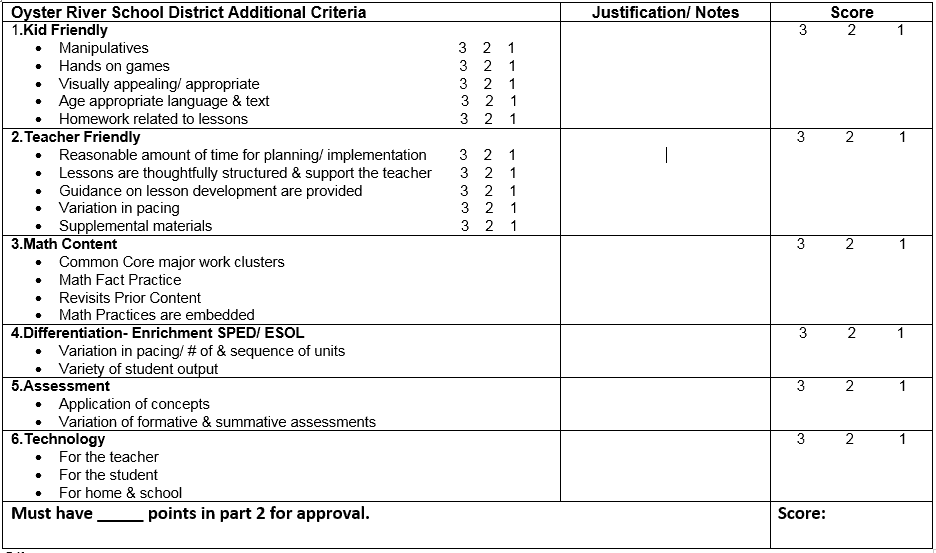In the spring of 2014, I had the opportunity be a part of a teacher-led materials selection process in the Oyster River School District in New Hampshire. I had been hired as Assistant Superintendent of Schools in Oyster River in July 2012 after having been a consultant for 12 years with the Council of Chief State School Officers (CCSSO) and the Wisconsin Center for Education Research. Our school district had been using Everyday Mathematics for about 10 years and with the adoption of the Common Core State Standards (CCSS), we knew it was time to re-examine whether Everyday Mathematics was a resource that was helping students learn the mathematics content required by the Standards.
We organized a mathematics committee representing grades K-5 to research different textbook options and determine how these choices would help our students meet the CCSS for mathematics. I wanted the teachers on the committee to come to their own conclusions using a tool that provided an exploration of the textbooks that would be centered on the math content. I knew we needed non-negotiable criteria to allow for a focused and thorough review of resources. I suggested the Instructional Materials Evaluation Tool (IMET) as our review rubric after having been introduced to the IMET as a CCSSO consultant attending a meeting of State Education Agencies (SEAS).
Our committee was looking for a resource that was Common Core-aligned, had lots of resources to assist with differentiation and instructional best practice, and was both teacher- and student-friendly. At the same time, we all knew that the teachers were leaning toward Everyday Math because of their comfort level with the materials after having used the curriculum for so long. We also had a really great Everyday Math sales rep who was effective in convincing teachers that the textbook was REALLY aligned; publishing companies claiming 99% alignment to the CCSS without showing concrete evidence of the curriculum’s alignment caused concern, however. In the past, our district had selected resources after representatives came to present their products, or after our district heard of other districts using the textbook in the area, but this time we wanted to make an independent decision about what would help our student population meet the Standards.
All the K-5 teachers in the district were able to recommend mathematics resources for the committee to examine. We had about 5 submissions and most came from what our district’s teachers had heard from teachers in other districts. I contacted the companies and requested materials for us to explore.
Two teachers from each grade (K-5) met at the beginning of the summer for a half-day training on the IMET. I led the training, the purposes of which were to define the reasons for using this tool, to familiarize everyone with the tool, and to develop a common understanding of the non-negotiable criteria.
Using the IMET, we were able to rule out some options right away. Although this process might not have been completely without bias, the tool’s clear criteria were key! Having multiple scorers for each grade was very important, as well. That way, everyone stayed focused on the evidence versus being swayed by how they personally felt about the resource. I can’t say enough about the professional, content- and data- driven dialogue that ensued due to using the IMET. It was truly powerful to listen and watch the teacher discussions.
After having time to review materials, we met to discuss each resource so that teachers who had used the IMET on their own could then discuss what they found and talk about why they came up with certain scores for the different metrics.
Instead of using the IMET Section II –Additional Alignment Criteria and Indicators of Quality, we agreed that the committee would create our own list based on teachers’ input. The teachers on the committee created a list of all the criteria that mattered to them in a high-quality resource. Those of us on the committee prioritized the list – teachers put a sticker dot next to their top four most highly prized criteria. From there, we created the list of qualitative criteria that a new math resource would need to have in order to work for us.
 Additional criteria developed by the Oyster River School District that represents what the district’s teachers value in a math textbook.
Additional criteria developed by the Oyster River School District that represents what the district’s teachers value in a math textbook.
Now this is where the whole process got messy- we didn’t weight the criteria! So, the wish to have hands-on activities was given the same weight as the desire for resources that supported differentiation in the classroom. I would definitely recommend that other districts that choose to create their own set of criteria also agree ahead of time on the relative weights for each criteria since it’s unlikely you’ll find a resource that meets all your criteria equally well. In our committee, we had a long discussion about which resources met the criteria and what criteria are more important than other criteria and we came out with two resources – Everyday Math and Eureka.
In the end, it was the non-negotiable criteria in the IMET rather than the criteria in Section II, that created the quantitative data set that we needed to finalize a decision that every teacher could stand behind even it wasn’t his/her first choice. Its alignment to the non-negotiable criteria and its focus on mastery of content, made our final choice clear: Eureka Math!
We are now finishing up our first year of implementation with Eureka. It has been hard work for the teachers, but the increase in the student achievement in mathematics is evidence that we made the right choice. Teachers have expressed that they’re surprised as to how much students could learn at each grade level – it has been amazing! My hat’s off to these teachers for being true professionals and acting on what’s best for kids!
















